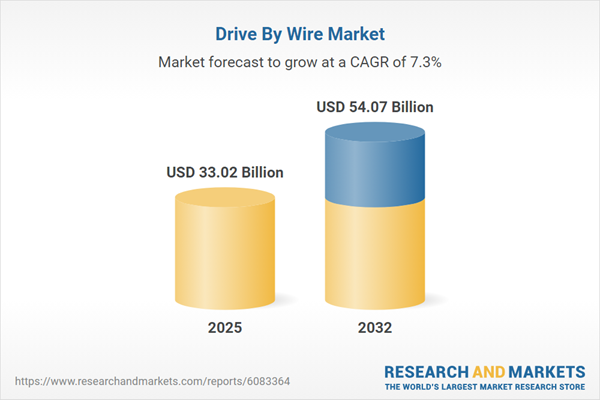Speak directly to the analyst to clarify any post sales queries you may have.
The drive-by-wire market is transforming how automotive manufacturers approach innovation, supply chains, and vehicle performance. As electronic control systems become the industry standard, senior decision-makers must align strategy with evolving digital, regulatory, and supply demands to maintain competitive momentum.
Market Snapshot: Global Drive By Wire Market Overview
The global drive-by-wire market expanded from USD 30.72 billion in 2024 to USD 33.02 billion in 2025, and it is set to reach USD 54.07 billion by 2032, advancing at a compound annual growth rate (CAGR) of 7.32%. Market growth is being fueled by rising demand for advanced electronic controls, an increasing shift toward electrified powertrains, and new regulatory standards for safety and emissions. Continued advancements in sensor technologies and system integration are enhancing vehicle platforms' efficiency and responsiveness, while market adoption is further boosted by dynamic growth across North America, Europe, Asia-Pacific, and the Middle East. As supply chains adjust for next-generation vehicle requirements, stakeholders gain access to evolving component architectures and deployment strategies.
Scope & Segmentation
- Throttle Control: Incorporates DC motors, stepper motors, Hall effect sensors, and potentiometers to optimize actuator performance and support consistent vehicle responsiveness and sensor longevity.
- Transmission Control: Includes automated manual, automatic, continuously variable, and dual clutch transmission systems designed to serve commercial and passenger vehicle segments.
- Vehicle Propulsion: Covers electric systems (battery and fuel cell), multiple hybrid architectures (full, mild, plug-in), and traditional internal combustion engines running on diesel and gasoline, delivering flexibility for diverse propulsion needs.
- Brake Control: Features electrohydraulic, hydraulic, and regenerative braking solutions that target requirements for commercial vehicles, passenger cars, two-wheelers, and off-highway equipment.
- Steering Control: Encompasses column, intermediate, and rack-and-pinion mechanisms that utilize electric, electrohydraulic, or hydraulic modules, supporting a range of operational and integration demands.
- Geographies Covered: Offers in-depth analysis for the Americas (United States, Canada, Mexico, Brazil, Argentina, Chile, Colombia, Peru), EMEA (including major European, Middle Eastern, and African markets), and Asia-Pacific (notably China, India, Japan, Australia, South Korea, and Southeast Asia).
- Key Companies Tracked: Highlights strategies and innovation models from Robert Bosch GmbH, Continental AG, Denso Corporation, ZF Friedrichshafen AG, Hyundai Mobis, BorgWarner Inc., Valeo SA, Hitachi Automotive Systems, Aisin Seiki, and NXP Semiconductors.
Key Takeaways for Senior Decision-Makers
- Drive-by-wire technologies are foundational to digital transformation in automotive platforms and support the evolution of autonomous, software-defined vehicles.
- Growth in electric and hybrid vehicle deployment raises the need for seamless integration of torque management and regenerative braking controls within component systems.
- OEMs and key suppliers are prioritizing modular architectures, enabling more agile software updates and facilitating compliance with evolving regulatory mandates.
- Regional policy diversity—especially in jurisdictions prioritizing electrification and digital innovation—continues to shape the pace of technology adoption and competitive positioning.
- Supply chain resilience is addressed through nearshoring, material alternatives, and strategic diversification to navigate uncertainties in international trade environments.
- Cybersecurity has become a focal point, with increased investment in encrypted communications and secure system architectures throughout the development and procurement processes.
Tariff Impact and Supply Chain Realignment
Recent US tariff changes affecting drive-by-wire components are driving manufacturers to adjust sourcing and production strategies. With a shift toward North American manufacturing capabilities and more diversified global supply bases, suppliers are adopting new materials and updating logistics to optimize tariff classifications. These strategies enable a more resilient supply chain, enhancing flexibility amid fluctuating trade conditions and supporting continued growth in advanced vehicle manufacturing.
Methodology & Data Sources
This report utilizes a robust methodology, bringing together insights from executive interviews, system integrator assessments, proprietary patent analytics, regulatory documentation, and technical literature. Scenario modeling and rigorous data triangulation ensure qualitative and quantitative drivers in the drive-by-wire market are thoroughly evaluated for strategic business planning.
Why This Report Matters
- Delivers targeted insights into emerging technology trends, competitive dynamics, and new opportunities shaping the drive-by-wire market segment.
- Empowers leadership teams to align investments, engineering initiatives, and procurement strategies in response to market shifts and regulatory developments.
- Supports executive decision-making by highlighting strategies for enhanced operational agility and mitigation of supply chain and competitive risks.
Conclusion
The drive-by-wire market stands at the intersection of electrification, regulatory transformation, and digital vehicle innovation. Leaders equipped with this analysis can adeptly navigate ongoing industry shifts and strategically position their organizations for future success.
Table of Contents
3. Executive Summary
4. Market Overview
7. Cumulative Impact of Artificial Intelligence 2025
Companies Mentioned
The companies profiled in this Drive By Wire market report include:- Robert Bosch GmbH
- Continental AG
- Denso Corporation
- ZF Friedrichshafen AG
- Hyundai Mobis Co., Ltd.
- BorgWarner Inc.
- Valeo SA
- Hitachi Automotive Systems, Ltd.
- Aisin Seiki Co., Ltd.
- NXP Semiconductors N.V.
Table Information
| Report Attribute | Details |
|---|---|
| No. of Pages | 192 |
| Published | October 2025 |
| Forecast Period | 2025 - 2032 |
| Estimated Market Value ( USD | $ 33.02 Billion |
| Forecasted Market Value ( USD | $ 54.07 Billion |
| Compound Annual Growth Rate | 7.3% |
| Regions Covered | Global |
| No. of Companies Mentioned | 11 |









